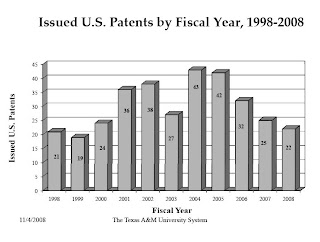... Centers and institutes shall be discussed with the board in concept prior to full-scale development of a proposal for its approval except where the delay for such discussion would jeopardize grant and contract funding of the center or institute because of externally imposed deadlines....The BoR only approved the concept and now has to consider the full-scale proposal.
Based on what Vision 1920 is hearing, the NCTM proposal may be attacked by the potbangers for not having a contingency plan in case the estimates of demand for partnerships in the industrial consortium are overly optimistic and the Center has a hard time generating the revenue needed to keep it going. About a year ago, BioPharm International Magazine discussed market trends for contract manufacturing organizations (CMOs) in pharma:
The biomanufacturing building boom is merging with several other industry trends to create a looming overcapacity situation in the industry.This was before the economy crashed last fall. Because the NCTM won't be finished for several years, perhaps the plan is that TEES will be able to buy capability low now, and sell high when the economy rebounds. But this may not satisfy the critics.
...
The excess capacity at the major bio/pharmaceutical companies could be a real challenge to the contract biomanufacturers. We've heard of at least one major company that has recently begun selling its excess capacity in the contract market. We've also heard from some CMOs that clients are reducing production at their CMOs in order to fill underutilized internal capacity.
Vision 1920 humbly offers an alternative contingency plan. We keep the NCTM acronym and tweak what it stands for. Faithful readers, Vision 1920 gives you a proposal for the:
National Center for "Therapeutic" Marijuana (NCTMj)
We admit that the inspiration for the NCTMj is comes from ideas to solve California's budget problems.
Ammiano introduced legislation last month that would legalize pot and allow the state to regulate and tax its sale — a move that could mean billions of dollars for the cash-strapped state. Pot is, after all, California's biggest cash crop, responsible for $14 billion a year in sales, dwarfing the state's second largest agricultural commodity — milk and cream — which brings in $7.3 billion a year, according to the most recent USDA statistics.Texas is in a perfect position to exploit this market in the way we pwned California in the glory days of Enron. Some of the benefits of modifying the NCTM to the NCTMj include:
- Provides a role for AgriLife in tIIT
- Would help Texas A&M recruit football stars who would otherwise go to the "Bonghorns"
- Would stimulate business at Frito-Lay, a major Texas company
- Problems with the Federal DEA will be moot after Gov. Perry has Texas secede (Note that this would also simplify implementing the Texas Policy Foundation's proposal to have our own accreditation system)
- People would not have to ask "what are they smoking?" when evaluating the revised proposal






